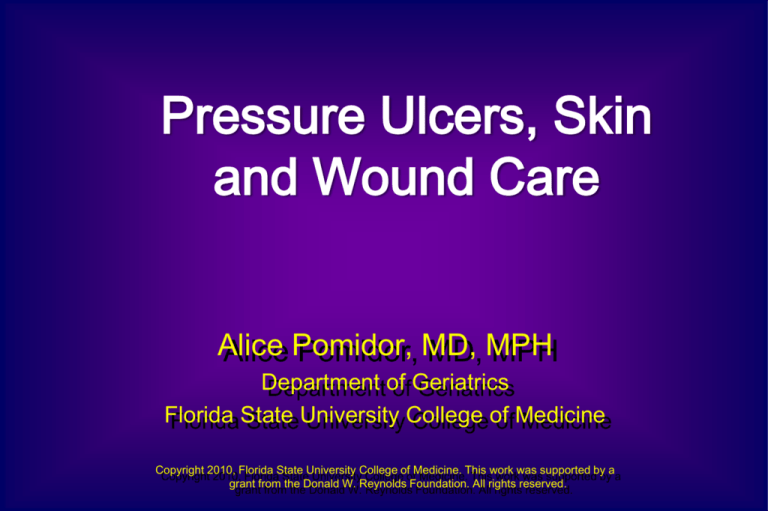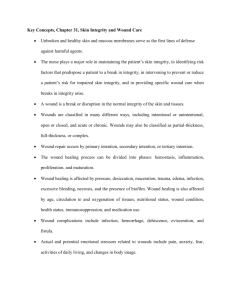
Pressure Ulcers, Skin
and Wound Care
Alice Pomidor, MD, MPH
Department of Geriatrics
Florida State University College of Medicine
Copyright 2010, Florida State University College of Medicine. This work was supported by a
grant from the Donald W. Reynolds Foundation. All rights reserved.
Objectives
Identify normal changes in aging skin and their
clinical impact
Recognize risk factors for skin damage and
pressure ulcers
Use the staging system for wounds
Choose pressure relief devices and strategies
Apply the 7 basic principles of wound care
Recognize different wound care products and
their appropriate applications
Case: Mrs. G
78 year old female type II diabetic
hypertensive with hyperlipidemia, probable
peripheral vascular disease
Meds: felodipine, lisinopril, glyburide, aspirin
Spot on foot, another on sacrum, recent
purulent drainage from foot
Lived alone b/f hospitalized for hip Fx,
smokes ½ ppd x 40 years, was indep ADLs
Pulses present 2+ carotids and radials, 2+
femorals, trace popliteals, DP & PT not
palpable bilaterally
Right foot
Skin Changes with Aging
Epidermis:
Less moisture
50% slower turnover
Flattened dermalepidermal junction
Dermis:
Less blood supply
Less elastin, collagen
20% less thickness
10 – 20% fewer
melanocytes/decade
Clinical Effects:
Increasing Age
Delayed wound healing
High prevalence of xerosis
Skin tears and blisters easily
Prone to sun damage, malignancy
Risk Factors
Decreased mobility
Poor nutrition/hydration
Vascular compromise
Sensory impairment
Multiple medical comorbidities
Pressure: unrelieved on any firm surface
Moisture: incontinence, in skin folds
Friction: dragging across sheets, agitation
Shear: sliding down in bed. pushing up w/heels
Describe & measure accurately
Look!
Must see base of wound
The presence of necrotic material
means the wound cannot be staged: “at
least” a stage III
Record all 3 dimensions of length, width
and depth
Wound Staging
Stage I: Erythema not resolved w/in 30 min pressure relief.
Epidermis remains intact. Reversible with intervention.
Stage II: Abrasion, blister, or shallow crater w/ partialthickness skin loss of epidermis and/or dermis. No
subcutaneous necrosis.
Stage III: Crater unless covered by eschar. Full-thickness
skin loss through the dermis into subcutaneous tissue.
Stage IV: Deep crater, tissue destruction extending to
fascia, possibly including muscles, tendons, joint capsule,
and/or bone.
Wound Care Principles
Describe/measure wound accurately
Put the patient in the right place at the right time
Achieve a clean, uninfected wound
Provide a moist environment suitable for healing
Minimize disruption of wound surface
Prevent damage to viable tissue: SALINE!
Feed, water, oxygenate the patient to
compensate for fluid and calorie loss
Put the patient in the right
place at the right time
Choose appropriate support surfaces
Change positions q2h when supine &
q1h when up
Reevaluate the wound q1-2 weeks
Extremity padding
Heelbo/Elbo
Heel pillow
Multipodus splint
Ankle ring
Pressure Relief Seating
Eggcrate
Sheepskin
Gel
Foam
Roho
Pressure Relief Beds
Alternating
mattress overlay
Air-fluidized
Low Air Loss
Wound Care Principles
Describe/measure wound accurately
Put the patient in the right place at the right time
Achieve a clean, uninfected wound
Provide a moist environment suitable for healing
Minimize disruption of wound surface
Prevent damage to viable tissue: SALINE!
Feed, water, oxygenate the patient to
compensate for fluid and calorie loss
“ Clean” Wound
Macrodebridement
– Sharp vs. blunt
– Maggots
Microdebridement
– Wet-to-dry dressings
Enzymatic debridement
– Collegenase
– Papain
Autolytic debridement
– Occlusive dressings
Dressings-Gauze
Uninfected Wound
All wounds are colonized
No surface cultures; deep cultures OK
Anaerobic organisms plus skin flora
Cellulitis—reactive vs. infective
hyperemia
Consider osteomyelitis if less than 1 cm
from a bony surface and/or no healing
in 3 months
Local agents only reduce overgrowth
(silver, metronidazole, mesalt)
Wound Care Principles
Describe/measure wound accurately
Put the patient in the right place at the right time
Achieve a clean, uninfected wound
Provide a moist environment suitable for healing
Minimize disruption of wound surface
Prevent damage to viable tissue: SALINE!
Feed, water, oxygenate the patient to
compensate for fluid and calorie loss
Moist environment
If it’s wet, dry it (alginate, hydrofiber,
foam)—excess drainage apparent
If it’s dry, wet it (hydrogel)—secondary
film of dried material will become visible
If it’s just right, keep it that way
(hydrocolloid or hydrogel)
Minimize disruption
Dressing changes traumatize the healing
wound surface
Goal: once per day
Better: even less often!
Also more cost effective when accounting
for nursing time
Creams & Ointments
Ointments
Dessicators,
Antiseptics
Barrier Creams
Enzymes
Platelet
Growth Factor
Protease Inhibitors
Creams & Ointments
•Zinc, A&D, petroleum
•Dakin’s solution, iodoform, peroxide
•Silvadene, metronidazole, antibiotic
Dressings/Films
Antiseptic
Dressings
Thin Films:
Opsite, Tegaderm
Foam
Wafers
Impregnated
Gauzes
Dressings/Films
Dressings/Films
Gels, Colloids plus
Hydrocolloids
Hydrogels
Alginates,
hydrofibers
Biologicals
& Grafts
Gels, Colloids, Alginates,
Biologicals
Wound Care Principles
Describe/measure wound accurately
Put the patient in the right place at the right time
Achieve a clean, uninfected wound
Provide a moist environment suitable for healing
Minimize disruption of wound surface
Prevent damage to viable tissue: SALINE!
Feed, water, oxygenate the patient to
compensate for fluid and calorie loss
Preserve viable tissue
Everything except saline is cytotoxic in
wet-to-dry dressings
Always use saline for cleansing
Beware of commercial cleansers or
antibiotic topicals
Protect the surrounding skin (tape
anchors, petroleum)
Shield wound/skin from incontinence
Feed, water and oxygenate
Stress-level protein/calorie replacement
– 1.5 gm/kg/d of protein
– 30 kcal/kg/d
Minimum 125% daily fluid requirements
for insensible loss & drainage
Consider transfusion for Hgb <9.0
Keep blood sugars below 200
Assess nutrition by Hgb & prealbumin
q2 wks
Adjuvant Therapies
Compression: Ted hose, Jobst stockings, etc.
Support surfaces: Foam, gel, air and fluid-filled, etc.
Negative pressure therapy: lg, high-exudate wounds
Hydrotherapy: whirlpool debridement
Hyperbaric oxygen: anaerobic, radiation, salvage sites
Electrotherapy: low-intensity DC, AC. Limited data and
reimbursement
Ultrasound: results equivocal at best
Supplements: pentoxifylline, zinc, vit. C, oxandrolone
Mrs. G’s studies
Labs:
–
–
–
–
–
Glucose 200-280’s
Basic metabolic panel otherwise normal
Hgb/Hct 10/ 30
WBC 14.9, no shift
Albumin 3.0
X-ray: Negative for osteomyelitis
Dopplers: Significantly impaired arterial blood flow,
right greater than left
Arteriogram: Significant disease of the trifurcation,
reconstituted below with collaterals
Mrs. G’s treatment plan
Use silver alginate/hydrofiber daily to the foot to
keep it moist
Debride sacral wound until the base can be seen;
consider enzyme to assist break up of slough
Refer to vascular surgeon for evaluation of possible
femoropopliteal bypass later
If bone visible on sacrum, IV antibiotics for possible
osteomyelitis followed by oral therapy for total 8
week course
Start protein supplement and check prealbumin,
Hgb 2 weeks later
Reduce blood sugars by increase in oral therapy
and use of sliding scale insulin to target range
150’s
Mrs. G’s treatment plan
Use extremity padding of some type; order mattress
overlay
Consider physiatry consult for weight-bearing
reduction orthotic for right foot as well as usual hip
rehab therapy
Encourage to walk to increase blood flow
Check fasting lipid profile
Reduce blood pressure with ACE inhibitor
Encourage to stop smoking
Consider subacute/nursing home placement for wound
care and physical therapy
Objectives
Identify normal changes in aging skin and their
clinical impact
Recognize risk factors for skin damage and
pressure ulcers
Use the staging system for wounds
Choose pressure relief devices and strategies
Apply the 7 basic principles of wound care
Recognize different wound care products and
their appropriate applications





